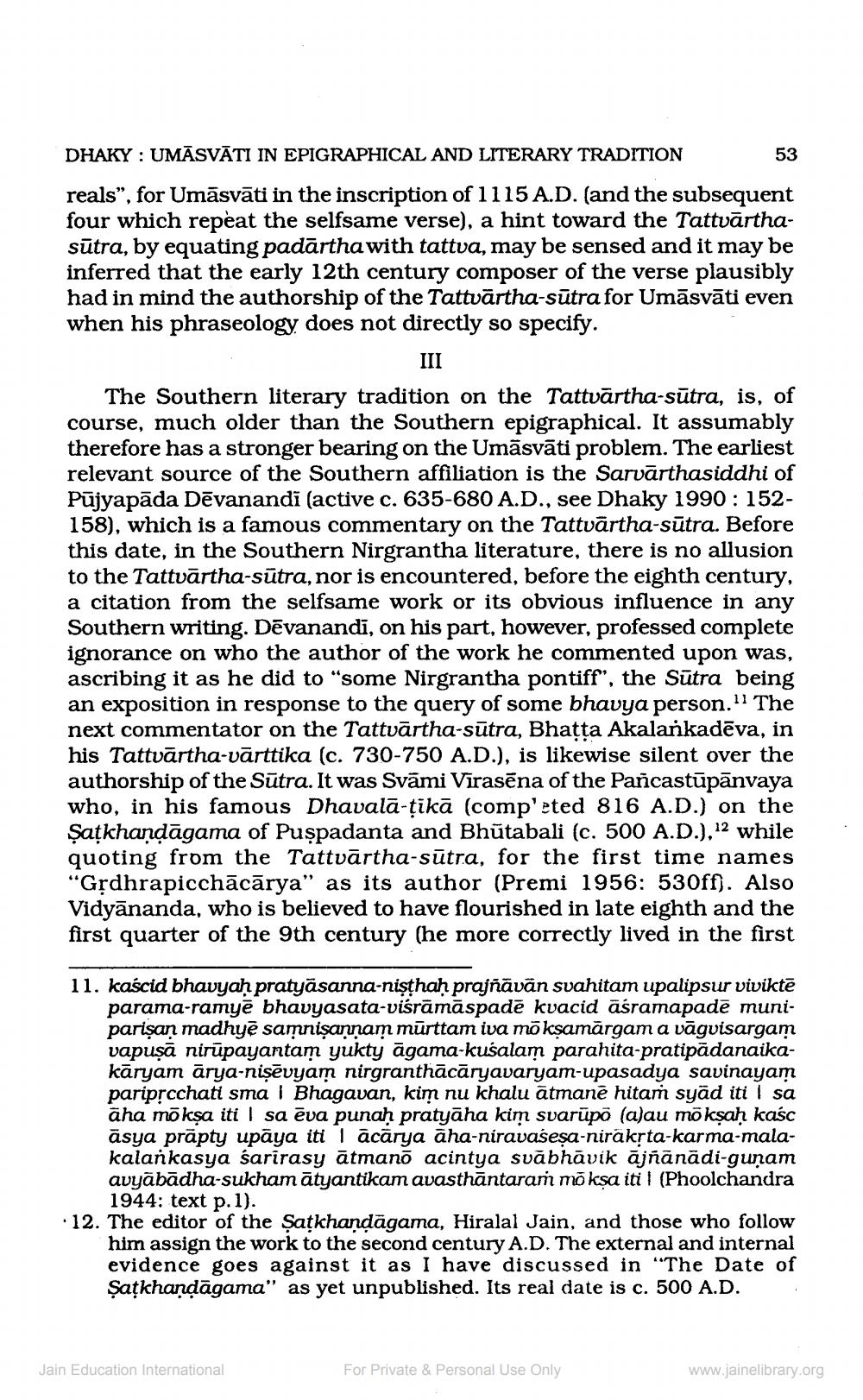________________
DHAKY: UMĀSVĀTI IN EPIGRAPHICAL AND LITERARY TRADITION
reals", for Umāsvāti in the inscription of 1115 A.D. (and the subsequent four which repeat the selfsame verse), a hint toward the Tattvārthasūtra, by equating padartha with tattua, may be sensed and it may be inferred that the early 12th century composer of the verse plausibly had in mind the authorship of the Tattvärtha-sūtra for Umāsvāti even when his phraseology does not directly so specify.
III
The Southern literary tradition on the Tattvartha-sūtra, is, of course, much older than the Southern epigraphical. It assumably therefore has a stronger bearing on the Umãsvāti problem. The earliest relevant source of the Southern affiliation is the Sarvārthasiddhi of Pūjyapāda Dēvanandi (active c. 635-680 A.D., see Dhaky 1990: 152158), which is a famous commentary on the Tattvārtha-sūtra. Before this date, in the Southern Nirgrantha literature, there is no allusion to the Tattvartha-sūtra, nor is encountered, before the eighth century, a citation from the selfsame work or its obvious influence in any Southern writing. Devanandi, on his part, however, professed complete ignorance on who the author of the work he commented upon was, ascribing it as he did to "some Nirgrantha pontiff", the Sūtra being an exposition in response to the query of some bhavya person." The next commentator on the Tattvārtha-sūtra, Bhaṭṭa Akalankadēva, in his Tattvārtha-vārttika (c. 730-750 A.D.), is likewise silent over the authorship of the Sutra. It was Svāmi Virasēna of the Pañcastūpānvaya who, in his famous Dhavalā-ṭīkā (comp'eted 816 A.D.) on the Satkhanḍāgama of Puspadanta and Bhutabali (c. 500 A.D.), 12 while quoting from the Tattvārtha-sūtra, for the first time names "Gṛdhrapicchācārya" as its author (Premi 1956: 530ff). Also Vidyananda, who is believed to have flourished in late eighth and the first quarter of the 9th century (he more correctly lived in the first
53
11. kaścid bhavyaḥ pratyāsanna-niṣṭhaḥ prajñāvān svahitam upalipsur viviktē parama-ramye bhavyasata-visrāmāspade kvacid äśramapade muniparisan madhye samniṣannam mūrttam iva mō kṣamārgam a vāgvisargam vapuṣā nirupayantam yukty agama-kusalam parahita-pratipadanaikakāryam ārya-niṣēvyam nirgranthācāryavaryam-upasadya savinayam paripṛcchati sma | Bhagavan, kim nu khalu atmane hitam syad iti I sa äha mōkṣa iti | sa ēva punaḥ pratyāha kim svarūpō (a)au mōkṣaḥ kaśc āsya prāpty upaya iti | ācārya aha-niravaseṣa-nirākṛta-karma-malakalankasya sarirasy ātmanō acintya svābhāvik ājñānādi-guṇam avyābādha-sukham ātyantikam avasthāntaram mo kṣa iti (Phoolchandra 1944: text p. 1).
12. The editor of the Satkhanḍāgama, Hiralal Jain, and those who follow him assign the work to the second century A.D. The external and internal evidence goes against it as I have discussed in "The Date of Satkhanḍāgama" as yet unpublished. Its real date is c. 500 A.D.
Jain Education International
For Private & Personal Use Only
www.jainelibrary.org




